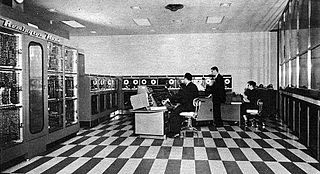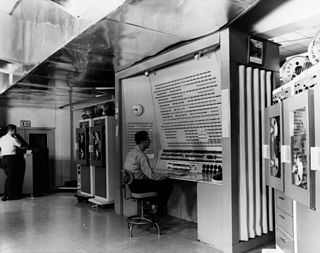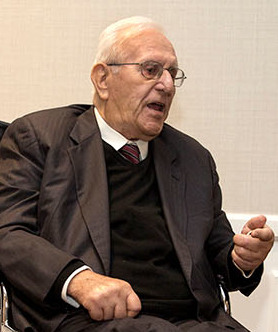
The TX-0, for Transistorized Experimental computer zero, but affectionately referred to as tixo, was an early fully transistorized computer and contained a then-huge 64K of 18-bit words of magnetic-core memory. Construction of the TX-0 began in 1955 and ended in 1956. It was used continually through the 1960s at MIT. The TX-0 incorporated around 3,600 Philco high-frequency surface-barrier transistors, the first transistor suitable for high-speed computers. The TX-0 and its direct descendant, the original PDP-1, were platforms for pioneering computer research and the development of what would later be called computer "hacker" culture.

The GE-200 series was a family of small mainframe computers of the 1960s, built by General Electric (GE). GE marketing called the line Compatibles/200 (GE-205/215/225/235). The GE-210 of 1960 is not compatible with the rest of the 200 series.

UNIVAC was a line of electronic digital stored-program computers starting with the products of the Eckert–Mauchly Computer Corporation. Later the name was applied to a division of the Remington Rand company and successor organizations.
The Cyclone, was a vacuum tube computer, built by Iowa State College at Ames, Iowa. The computer was commissioned in July 1959. It was based on the IAS architecture developed by John von Neumann. The prototype was ILLIAC, the University of Illinois Automatic Computer. The Cyclone used 40-bit words, used two 20-bit instructions per word, and each instruction had an eight-bit op-code and a 12-bit operand or address field. In general IAS-based computers were not code compatible with each other, although originally math routines which ran on the ILLIAC would also run on the Cyclone.

The IBM 700/7000 series is a series of large-scale (mainframe) computer systems that were made by IBM through the 1950s and early 1960s. The series includes several different, incompatible processor architectures. The 700s use vacuum-tube logic and were made obsolete by the introduction of the transistorized 7000s. The 7000s, in turn, were eventually replaced with System/360, which was announced in 1964. However the 360/65, the first 360 powerful enough to replace 7000s, did not become available until November 1965. Early problems with OS/360 and the high cost of converting software kept many 7000s in service for years afterward.

The history of computing hardware starting at 1960 is marked by the conversion from vacuum tube to solid-state devices such as transistors and then integrated circuit (IC) chips. Around 1953 to 1959, discrete transistors started being considered sufficiently reliable and economical that they made further vacuum tube computers uncompetitive. Metal-oxide-semiconductor (MOS) large-scale integration (LSI) technology subsequently led to the development of semiconductor memory in the mid-to-late 1960s and then the microprocessor in the early 1970s. This led to primary computer memory moving away from magnetic-core memory devices to solid-state static and dynamic semiconductor memory, which greatly reduced the cost, size, and power consumption of computers. These advances led to the miniaturized personal computer (PC) in the 1970s, starting with home computers and desktop computers, followed by laptops and then mobile computers over the next several decades.

The LGP-30, standing for Librascope General Purpose and then Librascope General Precision, was an early off-the-shelf computer. It was manufactured by the Librascope company of Glendale, California, and sold and serviced by the Royal Precision Electronic Computer Company, a joint venture with the Royal McBee division of the Royal Typewriter Company. The LGP-30 was first manufactured in 1956, at a retail price of $47,000, equivalent to $470,000 in 2021.

The BRLESC I was one of the last of the first-generation electronic computers. It was built by the United States Army's Ballistic Research Laboratory (BRL) at Aberdeen Proving Ground with assistance from the National Bureau of Standards, and was designed to take over the computational workload of EDVAC and ORDVAC, which themselves were successors of ENIAC. It began operation in 1962. The Ballistic Research Laboratory became a part of the U.S. Army Research Laboratory in 1992.

The TRADIC was the first transistorized computer in the USA, completed in 1954.

The MISTIC, or Michigan State Integral Computer, was the first computer system at Michigan State University and was built by its students, faculty and staff in 1957. Powered by vacuum tubes, its design was based on ILLIAC, the supercomputer built at University of Illinois at Urbana–Champaign, a descendant of the IAS architecture developed by John von Neumann.

The surface-barrier transistor is a type of transistor developed by Philco in 1953 as an improvement to the alloy-junction transistor and the earlier point-contact transistor. Like the modern Schottky transistor, it offered much higher speed than earlier transistors and used metal–semiconductor junctions, but unlike the schottky transistor, both junctions were metal–semiconductor junctions.

A transistor computer, now often called a second-generation computer, is a computer which uses discrete transistors instead of vacuum tubes. The first generation of electronic computers used vacuum tubes, which generated large amounts of heat, were bulky and unreliable. A second-generation computer, through the late 1950s and 1960s featured circuit boards filled with individual transistors and magnetic core memory. These machines remained the mainstream design into the late 1960s, when integrated circuits started appearing and led to the third-generation computer.

Mailüfterl is a nickname for the Austrian Binär dezimaler Volltransistor-Rechenautomat, an early transistorized computer. Other early transistorized computers included TRADIC, Harwell CADET and TX-0.
FLAC, the Florida Automatic Computer, was an early digital electronic computer built for the United States Air Force at Patrick Air Force Base (PAFB) in Brevard County of Florida, to perform missile data reduction. The computer began service in 1953.
The IBM 608 Transistor Calculator, a plugboard-programmable unit, was the first IBM product to use transistor circuits without any vacuum tubes and is believed to be the world's first all-transistorized calculator to be manufactured for the commercial market. Announced in April 1955, it was released in December 1957. The 608 was withdrawn from marketing in April 1959.

The Elea was a series of mainframe computers Olivetti developed starting in the late 1950s. The system, made entirely with transistors for high performance, was conceived, designed and developed by a small group of researchers led by Mario Tchou (1924–1961), with industrial design by Ettore Sottsass. The ELEA 9001 was the first solid-state computer designed and manufactured in Italy. The acronym ELEA stood for Elaboratore Elettronico Aritmetico and was chosen with reference to the ancient Greek colony of Elea, home of the Eleatic school of philosophy. About forty units were placed with customers. In August 1964, only a few years after releasing the 9003, Olivetti's mainframe business was sold to GE.

Arnold Meyer Spielberg was an American electrical engineer instrumental in contributions "to real-time data acquisition and recording that significantly contributed to the definition of modern feedback and control processes". For General Electric he designed, with his colleague Charles Propster, the GE-225 in 1959. He cited the first computer-controlled "point of sale" cash register as his greatest contribution. His children include filmmaker Steven Spielberg, and screenwriter Anne Spielberg.
The RCA 501 was a transistor computer manufactured by RCA beginning in 1958.
Philco was one of the pioneers of transistorized computers. After the company developed the surface barrier transistor, which was much faster than previous point-contact types, it was awarded contracts for military and government computers. Commercialized derivatives of some of these designs became successful business and scientific computers. The TRANSAC Model S-1000 was released as a scientific computer. The TRANSAC S-2000 mainframe computer system was first produced in 1958, and a family of compatible machines, with increasing performance, was released over the next several years.














